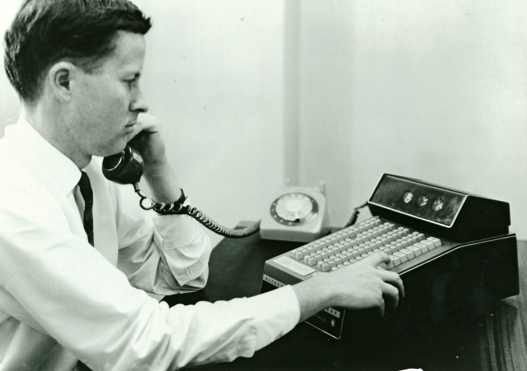Archives
Reuters technical development chronology 1964-1969
Monday 29 June 2015
- Reuters reaches an agreement with Ultronic Systems. Ultronics is taken over by General Telephone and Electronics - Telnet (GTEIS) which is later taken over by ADP. As well documented elsewhere, the agreement negotiated largely by general manager Michael Nelson gives Reuters exclusive rights to the Ultronic quotation and display systems and technology outside North America. In the basic Ultronic system, design ticker tapes from stock exchanges and other markets feed into a master computer which feeds into slave memory computers. These in turn are connected to client premises who obtain information by pressing keys on a small desktop unit similar to an adding machine with an electronic display. It is a broadcast and display system with the data stored on large magnetic drums and retrieved on “hardware only” Stockmaster terminals. It relies on the rapid movement of market information to overcome data loss. Reuters now moves into computerised price reporting and the technical development function starts under Glen Renfrew.
 As described in John Ransom’s article on Stockmaster, matching the master computer in New Jersey, a slave is installed in London. This avoids clients having to interrogate the New Jersey master over individual transatlantic lines.
As described in John Ransom’s article on Stockmaster, matching the master computer in New Jersey, a slave is installed in London. This avoids clients having to interrogate the New Jersey master over individual transatlantic lines.
PHOTO: John Ransom with Stockmaster
- The first transatlantic TDM (Time Division Multiplexer) is then installed by Ultronic and Reuters engineers so that the London master can be fed without renting another transatlantic circuit. This 2400bps link is said to be the first private circuit of its kind across the Atlantic. This is a huge leap forward for the UK telecommunications authority of the day (GPO) as at the time only Frequency Division Multiplexing is offered by them which is less reliable and less efficient. Reflecting the inventiveness of the day, the London data centre in 85 Fleet Street uses a fish and chip shop fitter to build the necessary operational consoles. An IBM1600 and then an IBM1800 - a cross between an early minicomputer and an industrial process control computer - is used to add some European stocks to the North American data stream.
- DEC (Digital Equipment Corporation) introduces the 12 bit PDP-8 minicomputer.
- Customprice is launched, a service of stock market data in computer readable form, it is initially delivered on punch cards and later on magnetic tape.
- The slave in London becomes a master and also handles prices from European and commodity stock exchanges. Clients in Europe are initially connected with 50bps links from London. The growth in such lines, along with existing teleprinter feeds, leads to a proposal in late 1966 for a European multiplexing solution to be known as Europlex. The proposal is returned with grammar corrected by senior management but is approved. Europlex uses a ring of circuits linking London-Paris-Geneva-Frankfurt-Amsterdam-London. It has a self-healing property whereby link failure routes traffic away from the failure the long way round. It is similar in technology to that used for the transatlantic communications and combines Stockmaster and all the teleprinter services in an 88 channel communications ring. The link operates at 4800bps which, over voice-grade circuits, was pushing the envelope somewhat. It goes live in August 1967. As the number of connections increase the first generation of slave storage units are progressively installed in Europe from which clients retrieve information directly. The first is in Geneva which goes live at the end of 1966. Additionally, each slave processes pricing data from local exchanges and feeds them into the international system. These first generation slaves are referred to as “unitised” because of their easy extensibility (an output unit is simply added to the system for each new subscriber connection). Regional technical support centres are created to support and maintain the systems. Digital communications and modems continue to perplex the telecommunications authorities (PTTs) and much training of them is undertaken by Reuters staff. There are now in excess of 1,100 desk units in 300 offices in 10 European countries.
- Reuters and Ultronic launch a US business wire of news delivered to teleprinters and video screens. The video display, known as videoscan, marks the first use of screens for textual news.
- Ultronic is taken over by General Telephone and Electronics Telnet Information Services (GTEIS).
- A second TDM system connects London with Montreal and New York. Both TDM systems use transistor-based technology and require constant maintenance and “tuning”.
- It is worth recalling that at this point there is not a video screen to be seen in Reuters - just teletypes, oscilloscopes and the like. Order wires (connected teletypes) are used instead of e-mail.
- A computerised message switching system (ADX) built by STC (Standard Telephones and Cables) and based on PDP-8s manufactured by DEC enters service in July 1968 and is the first of its kind to be used by a news organisation to drive printer services. It has 80 inputs and 80 outputs and replaces the labour-intensive electro-mechanical systems used for switching traffic.
- Ultronic/GTE announce Videomaster. An information and news retrieval system which is essentially Stockmaster on a screen with additional features such as the ability to change screen formats and set limits on stocks of interest.
- In-house applications are developed for the IBM computers which automate some clerical tasks and provide specially tailored lists of quotations to banks and brokers.
- It is announced that the original generation of clunky Siemens teleprinters are to be progressively replaced by devices that use heat transfer to print rather than ink.
- « Previous
- Next »
- 4 of 18